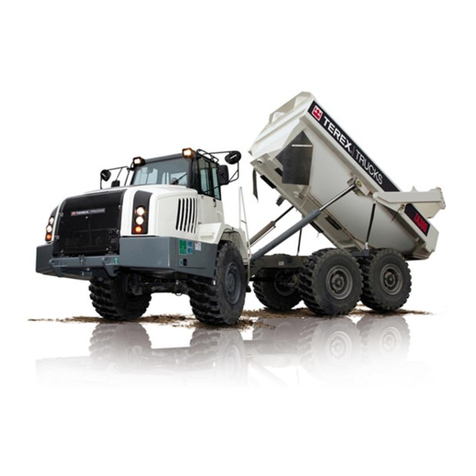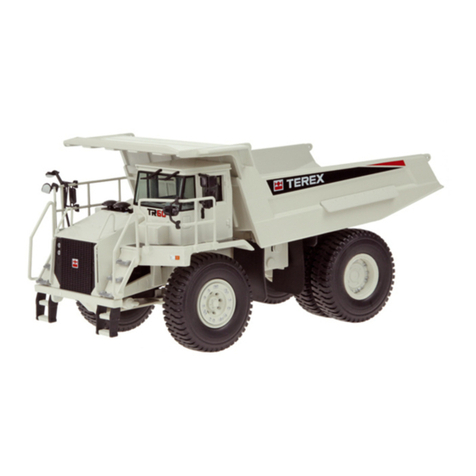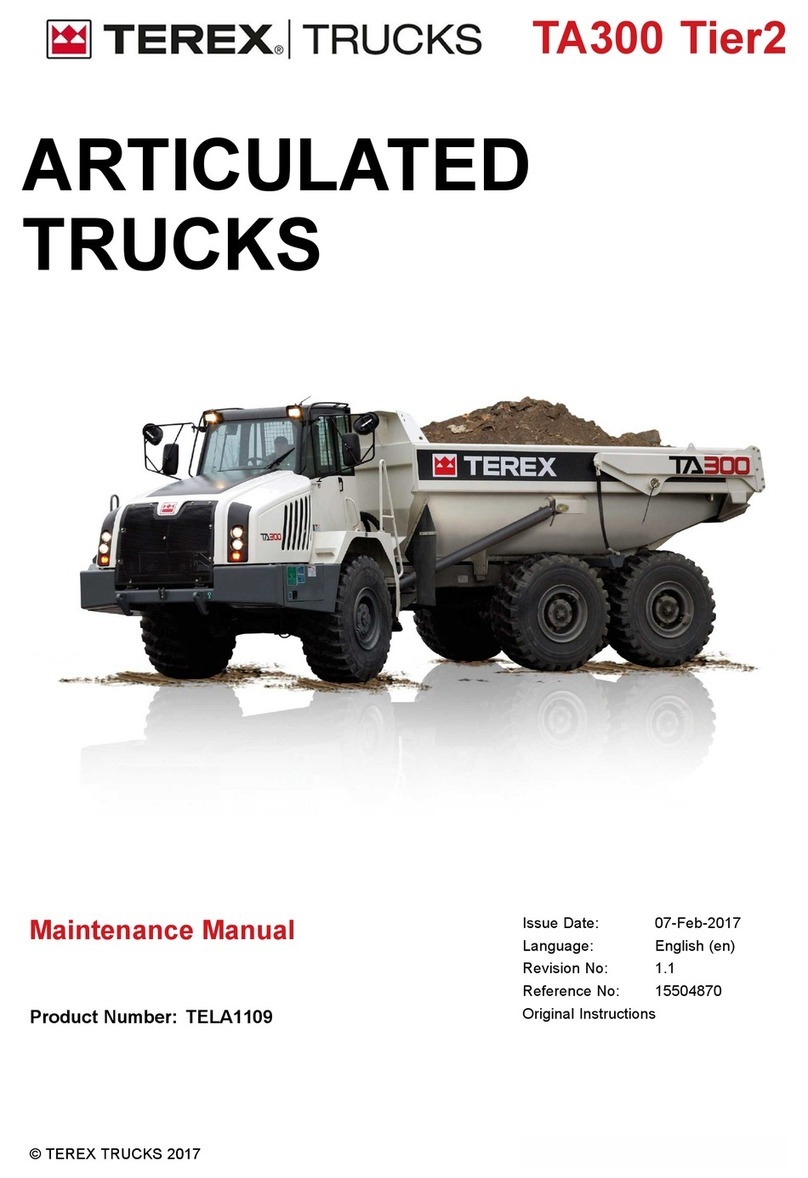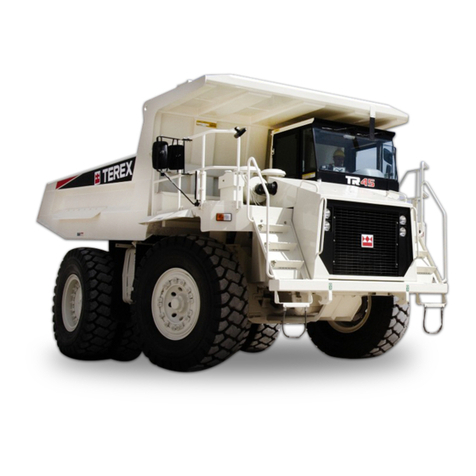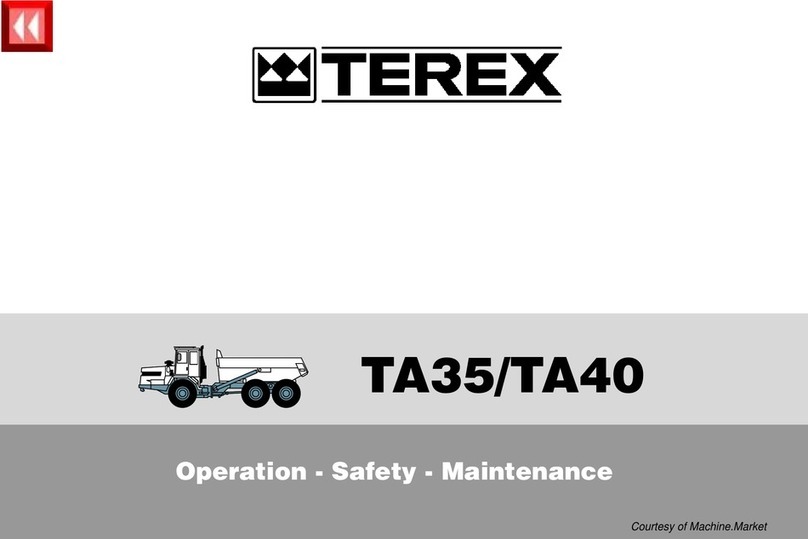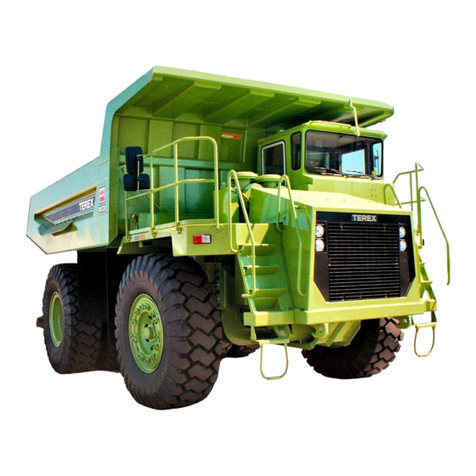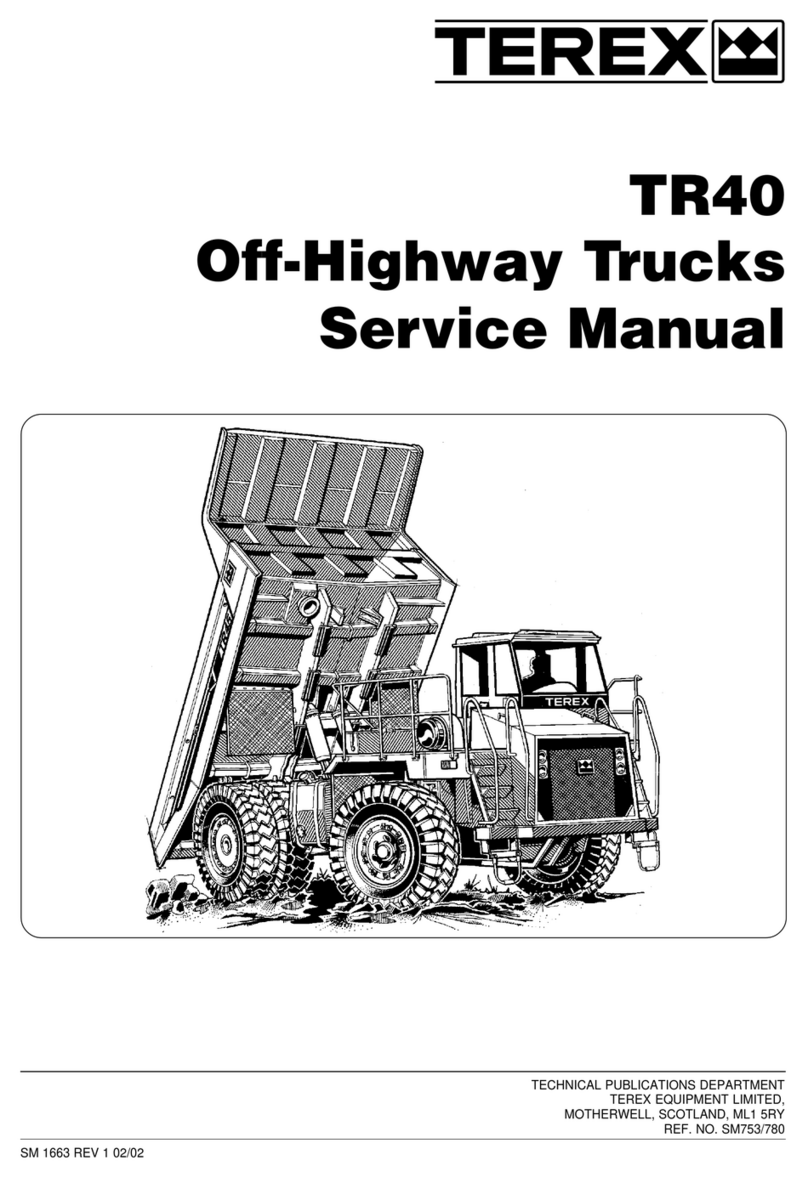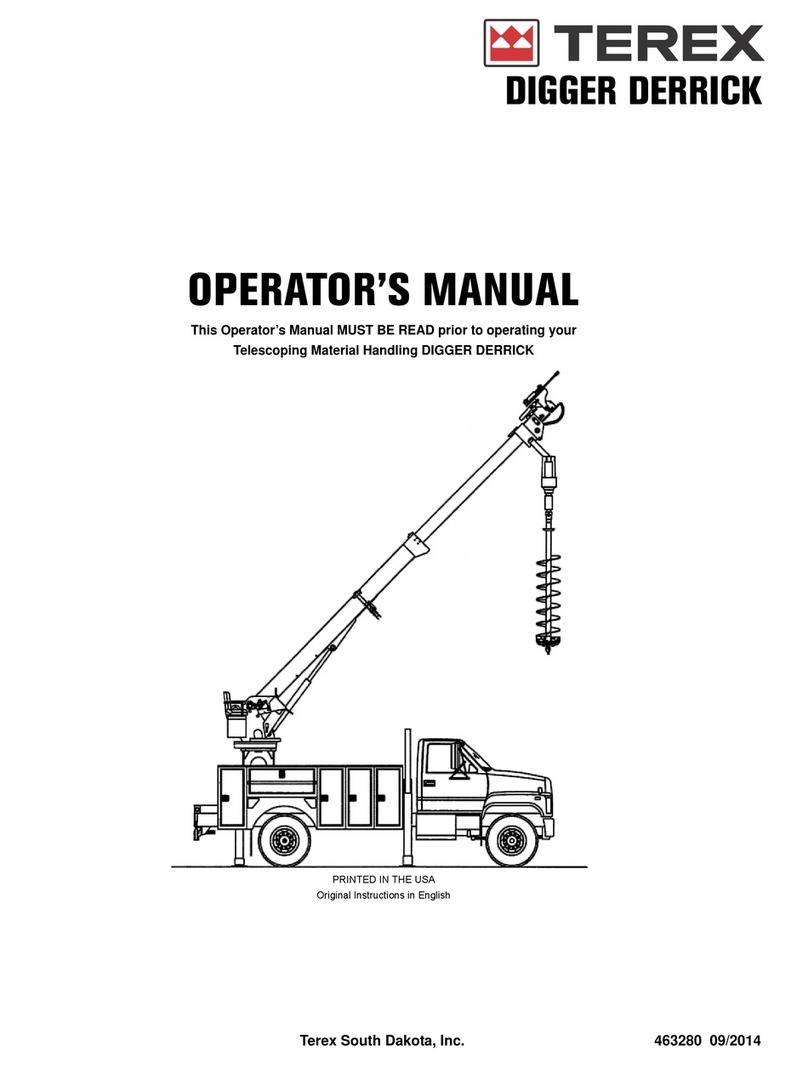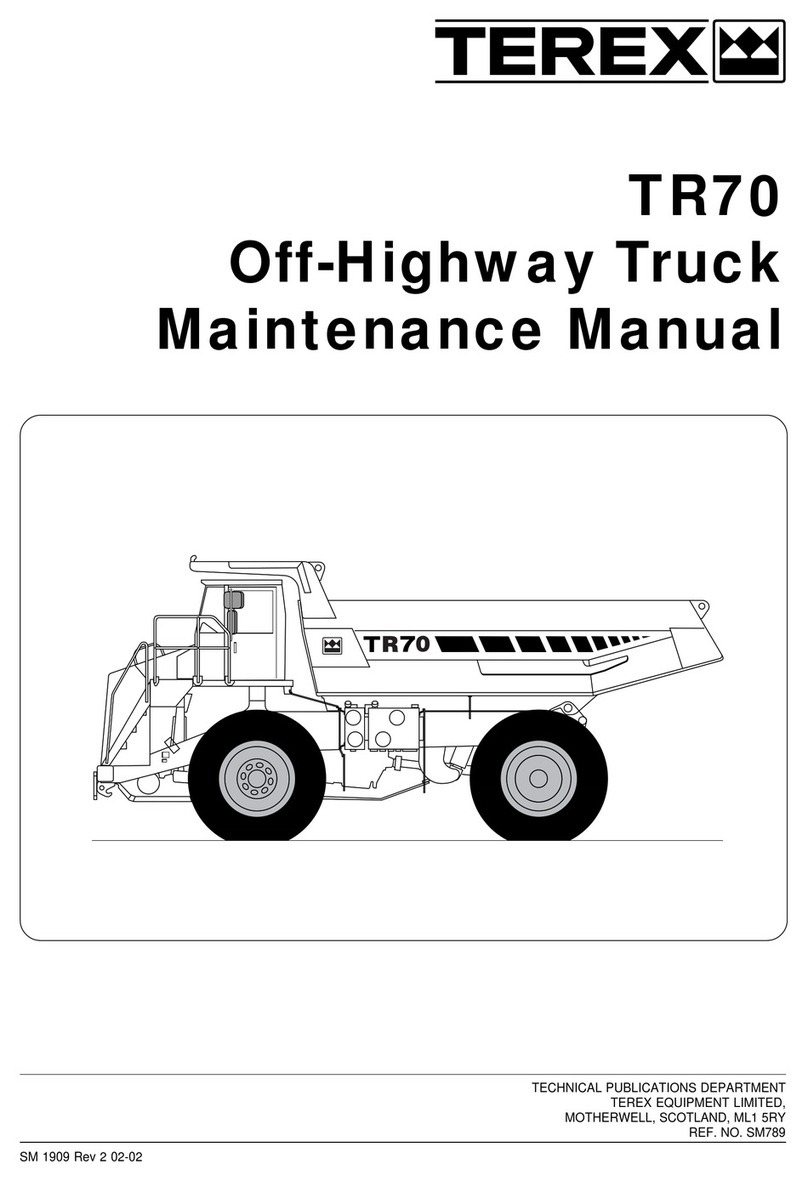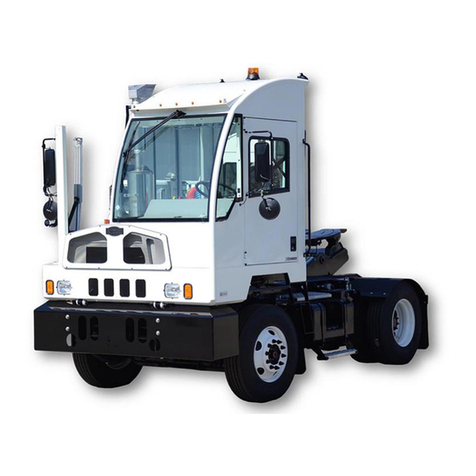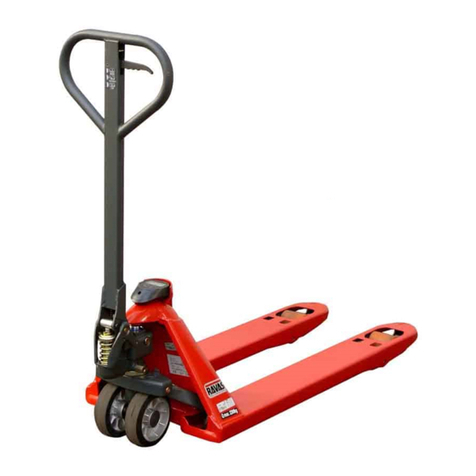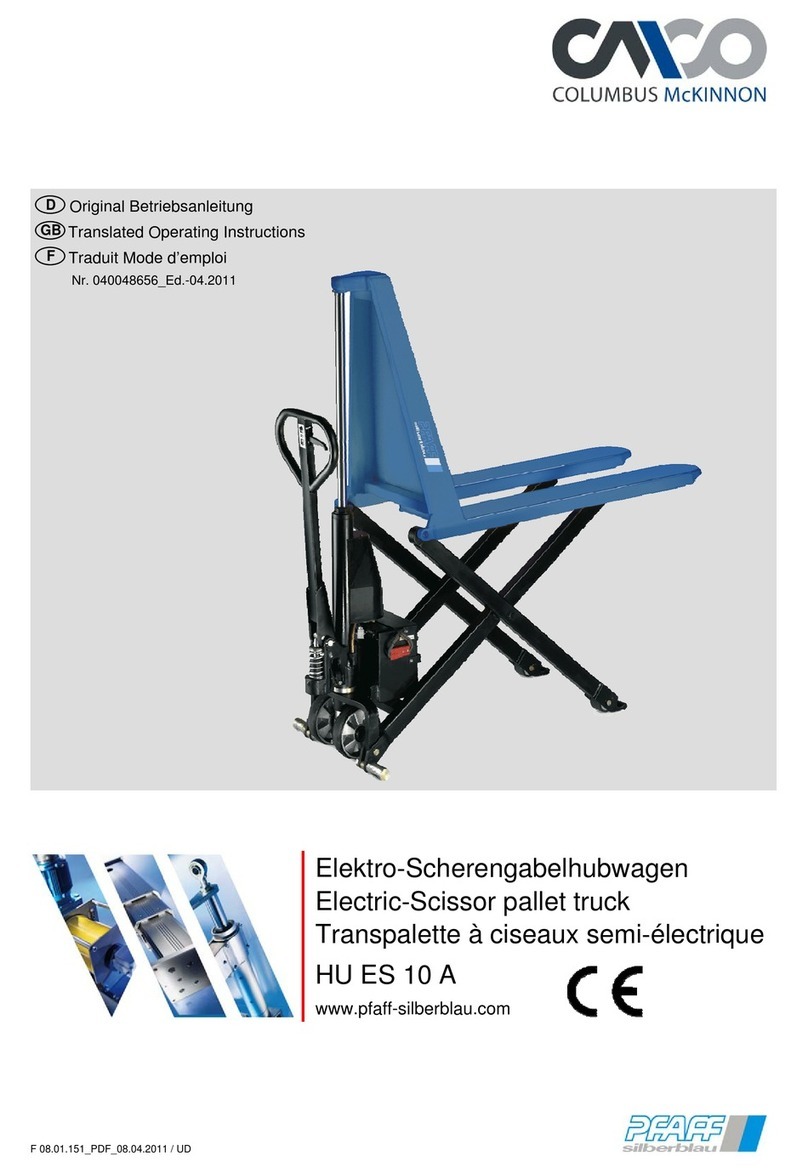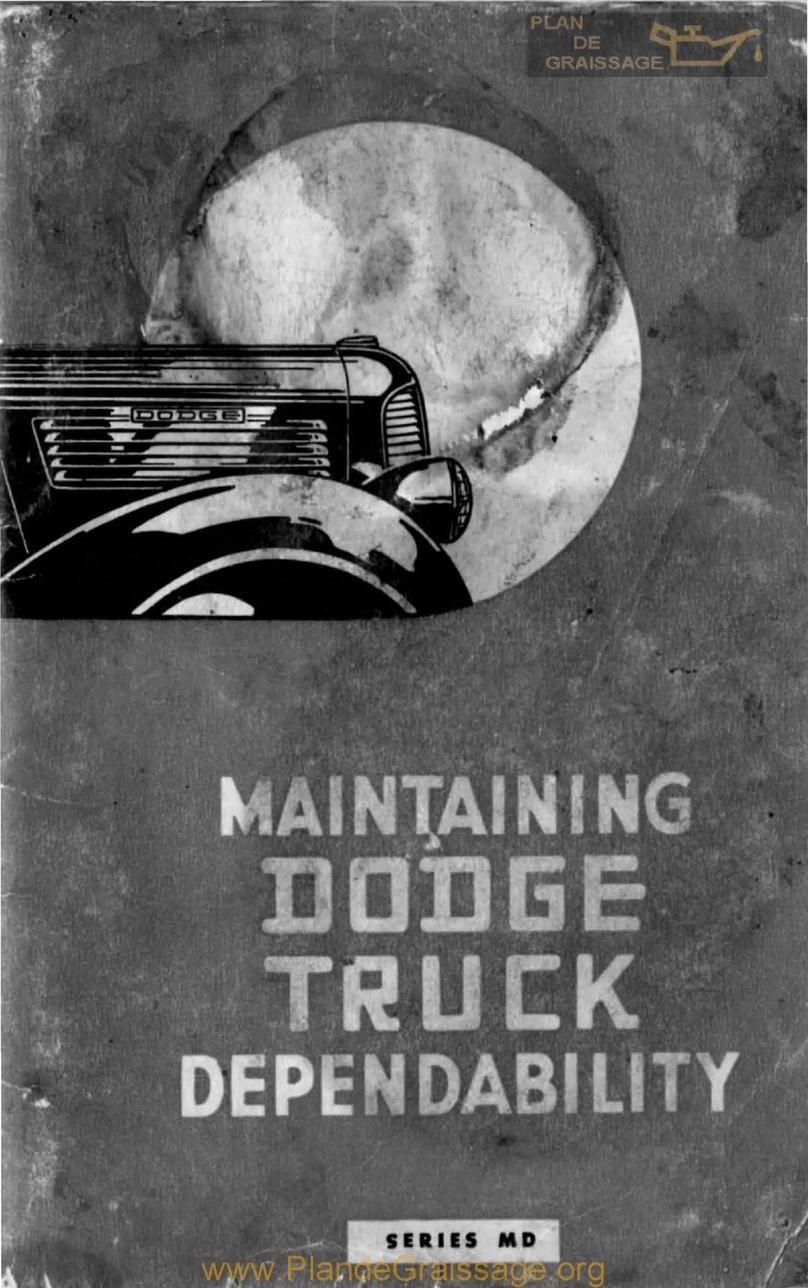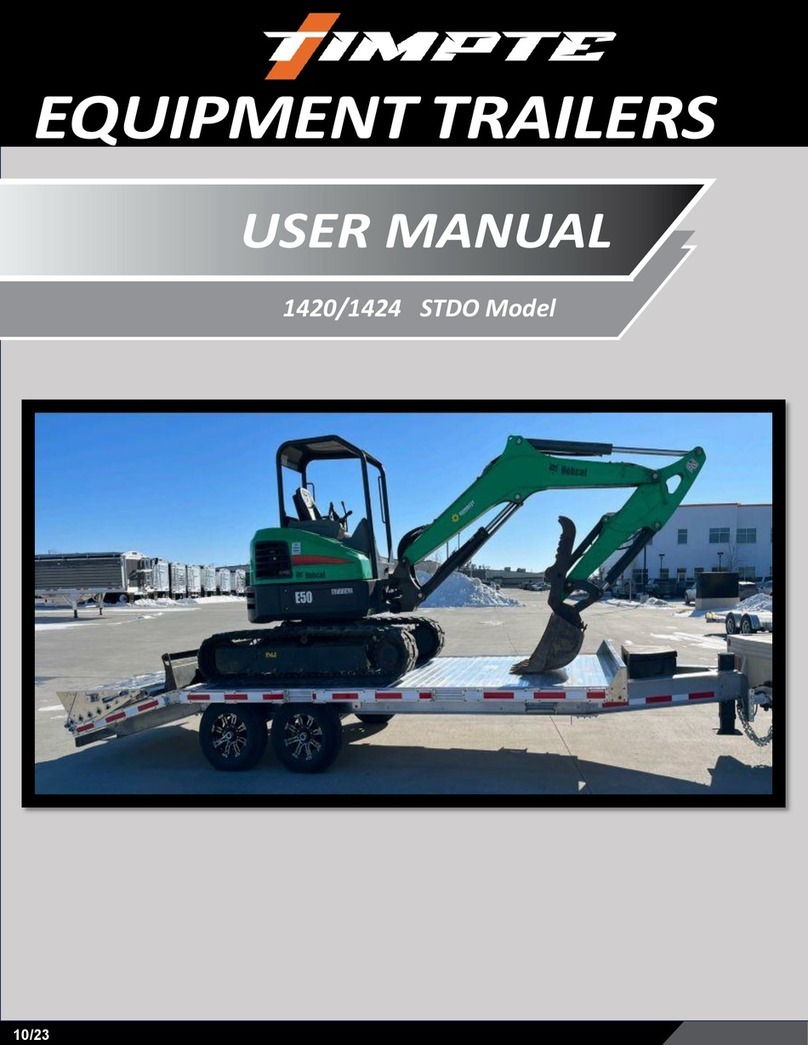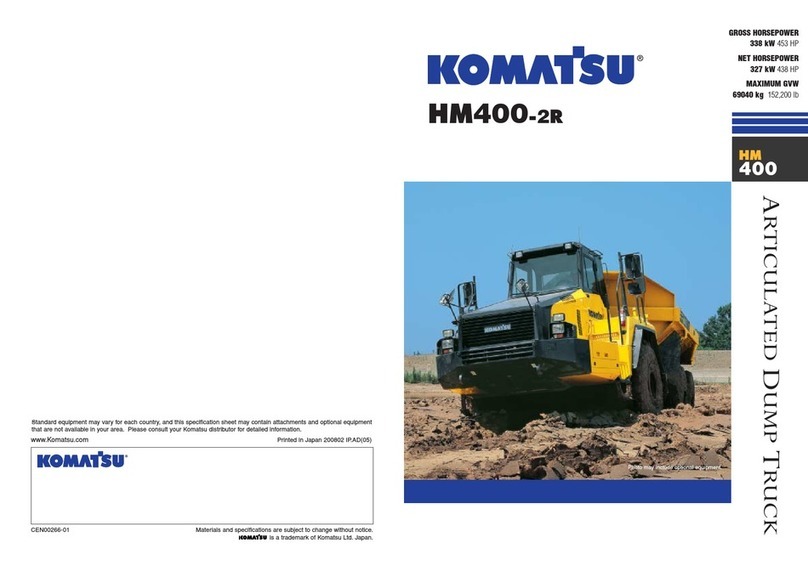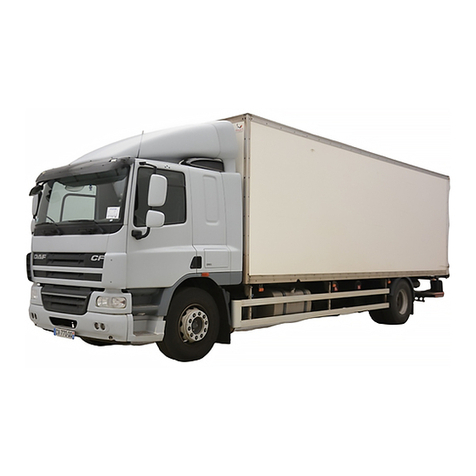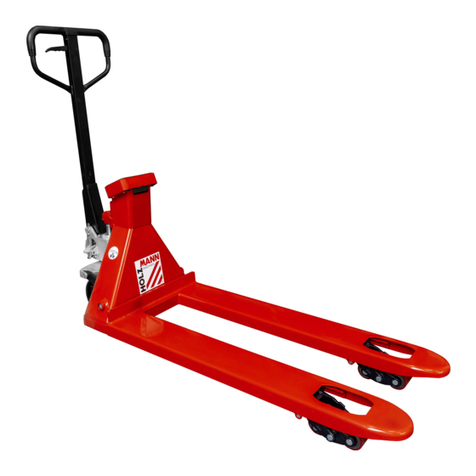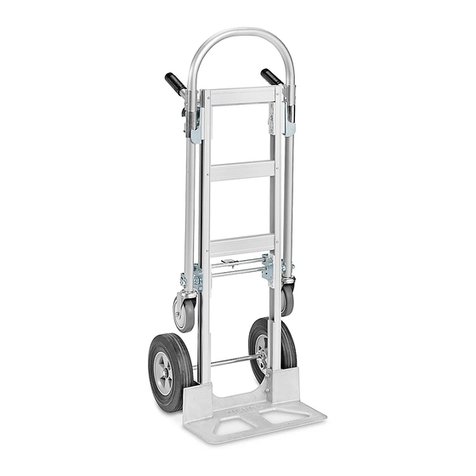Terex TA250 User manual

Proper service and repair is important to the safe, reliable operation of all motor vehicles. The
service procedures recommended and described in this publication, are effective methods for
performing service operations. Some of these service operations require the use of tools specially
designed for the purpose. The special tools should be used when, and as recommended.
It is important to note that this publication contains various WARNINGS and NOTES which should
be carefully read in order to minimize the risk of personal injury to personnel, or the possibility that
improper service methods will be followed which may damage the vehicle or render it unsafe. It is
also important to understand these WARNINGS and NOTES are not exhaustive. It is not possible to
know, evaluate and advise the service trade of ALL conceivable ways in which service might be
carried out, or, of the possible hazardous consequences of each way. Consequently, no such broad
evaluation has been undertaken. Accordingly, anyone who uses a service procedure, or tool, which
is not recommended, must first satisfy themselves thoroughly that neither their safety, nor vehicle
safety, will be jeopardized by the service method he/she selects.
Safety Alert Symbol
The safety alert symbol is used to alert you to a potential personal injury hazards. Obey all safety
messages that follow this symbol to avoid possible injury or death.
Hazard Classification
A multi-tier hazard classification system is used to communicate potential personal injury hazards. The
following signal words used with the safety alert symbol indicate a specific level of severity of the
potential hazard. Signal words used without the safety alert symbol relate to property damage and
protection only. All are used as attention getting devices throughout this manual as well as on deals
and labels fixed to the machinery to assist in potential hazard recognition and prevention.
DANGER DANGER indicates an imminently hazardous situation which, if not avoided, will
result in death or serious injury.
WARNING WARNING indicates a potentially hazardous situation which, if not avoided, could
result in death or serious injury.
CAUTION CAUTION indicates a potentially hazardous situation which, if not avoided, may
result in minor or moderate injury.
CAUTION CAUTION used without the safety alert symbol indicates a potentially hazardous
situation which, if not avoided, may result in property damage.
WARNING
Never use parts which are altered, modified, or weakened in operation. This can seriously jeopardise
the integrity of the machine and could result in property damage or serious personal injury.
IMPORTANT SAFETY NOTICE
Find manuals at https://best-manuals.com

MM 2745 06-12 1
Section No. Description MM No.
000
0000
0010
GENERAL INFORMATION
Technical Data - TA250
Welding Procedure
2738
2172
100
0010
0020
0030
CHASSIS
Frames
Articulation and Oscillation Pivot
Hood and Mounting
2744
2273
2713
110
0030
0050
0085
ENGINE
Engine and Mounting
Air Cleaner
SCR Exhaust System
2739
2176 Rev1
2678
120
0010
TRANSMISSION
Transmission and Mounting 2740
130
0010
DRIVELINES
Front and Rear Drivelines 2229
140
0020
0040
0060
0100
FRONT AXLE GROUP
Axle Group (Hub) (Refer to Section 160-0030)
Wheel Rim and Tyre (Refer to Section 160-0050)
Differential Drive Head (Refer to Section 160-0020)
Differential Lock Controls
-
-
-
2645
150
0020
CENTRE AXLE
Differential Drive Head 2646
160
0020
0030
0050
REAR AXLE GROUP
Differential Drive Head
Axle Group (Hub)
Wheel Rim and Tyre
1969
2194 Rev1
2649
165
0010
BRAKE ASSEMBLY
Oil Immersed Disc Brakes (Refer to Section 160-0030) -
170
0010
PARKING BRAKE
Parking Brake and Mounting 2650
180
0020
0020
0040
SUSPENSION SYSTEM
Front Suspension
Front Suspension (IFS)
Rear Suspension
2743
2651
2652
190
0000
0270
ELECTRICAL SYSTEM
Circuit Diagrams
Switches and Sensors
2653 Rev1
2728
TABLE OF CONTENTS
Find manuals at https://best-manuals.com

MM 2745 06-12 3
Section No. Description MM No.
200
0040
0051
FUEL SYSTEM
Fuel System
Electronic Foot Pedal
2657 Rev1
2472
210
0000
0040
0060
0100
COOLING SYSTEM
Cooling System
Radiator and Mounting
Transmission Oil Cooler
Hydraulic Oil Cooler
2658 Rev1
2720
2724
2191 Rev1
215
0050
MAIN HYDRAULIC VALVE
Main Hydraulic Valve Assembly 2725
220
0000
0090
0120
STEERING SYSTEM
Steering System Schematic
Steering Valve
Steering Cylinder
2661
2662
2677
230
0000
0040
0050
0081
0130
BODY SYSTEM
Body System Schematic
Hydraulic Tank
Main Hydraulic Pump
Body Control Lever
Body Cylinder
2727
2350 Rev1
2664
2726
2207
250
0000
0060
0070
BRAKING SYSTEM
Braking System Schematic
Accumulators
Treadle Valve
2730
2667
2668
260
0010
0090
0110
0130
OPERATOR'S COMPARTMENT
Cab and Mounting
Driver Seat and Mounting
Instructor Seat and Mounting
Air Conditioning
2669 Rev1
2670
2729
2671 Rev1
270
0010
BODY
Body and Mounting 2741
300
0020
0070
0080
0080
0090
MISCELLANEOUS
Lubrication System
Service Tools
Axle Bolt and Nut Torque Specifications
Standard Bolt and Nut Torque Specifications
Unit Storage
2742
2726
1521
2674
2629
TABLE OF CONTENTS
* * * *
Find manuals at https://best-manuals.com

GENERAL INFORMATION - Technical Data TA250
MM 2738 06-12 1
Section 000-0000
GENERAL INFORMATION - Technical
Data TA250
ENGINE
Note: The Tier IV Engines meets ACEA E7
specifications.
2 200
(7-2)
1 310
(4-4)
2 945
(9-8)
4 930
(16-2)
5 000
(16-5)
1 690
(5-6)
1 410
(4-9)
2 175
(7-0)
725
(2-3)
2 740
(8-11)
2 685
(8-10)
2 895
(9-6)
2 895
(9-6)
3 420
(11-2)
3 120
(10-3)
405
(1-6)
1 580
(5-3)
1 240
(4-1)
6 015
(19-9)
45˚
65˚
Max.
Body
Depth
SAE Turning Radius
Clearing Radius
8 470mm (27-9)
8 950mm (29-4)
4 230
(13-10)
2 575
(8-5)
9 930
(32-6)
Dimensions in
mm (ft-in)
MOT00437
Fig. 1 - Machine Dimensions
MOT00437
Make / Model Scania DC09 Cooling Coolant (50% Water
and 50% Glycol -
antifreeze)
Fuel injection Scania XPI Valve clearances, cold engine
intake valve (mm/in)
outlet valve (mm/in)
0.45/0.02
0.70/0.03
Number of cylinders and con-
figuration
5, straight Number of teeth on the flywheel 158
Working principle 4 stroke engine Low idle speed (rpm) 600 - 750
Cylinder diameter (mm/in) 130/5.12 Maximum full-load speed (rpm) 2 100
Cylinder diameter (mm/in) 140/5.51 Maximum torque at speed (rpm) 1 300
Displacement (dm³/in³)9.3/567.5 Fuel Diesel (10 PPM)
Firing sequence 1-2-4-5-3 Oil pan capacity 32 - 38 litres
Power Range 232 kW Weight, without coolant and oil
(kg/lb)
950/2 094
Compression ratio 16:1
Engine direction of rotation,
viewed from rear
Anticlockwise
Fan direction of rotation,
viewed from front
Clockwise
Find manuals at https://best-manuals.com

GENERAL INFORMATION - Technical Data TA250
2MM 2738 06-12
Section 000-0000
TRANSMISSION
Make/Model.................ZF 6WG 260 RPC Automatic
with manual override.
The transmission assembly consists of a torque
converter close-coupled to a countershaft-type
gearbox with an integral output transfer gearing.
There is automatic shifting throughout the range with
a kickdown feature. Lockup action in all forward
gears. A torque proportioning output differential
transmits drive permanently to the front and rear
axles. This differential may be locked by the operator
for use in difficult traction conditions. There is a
standard integral hydraulic retarder automatically
operates should the engine overspeed. A blocked
filter indicator and filter bypass system provide valve
block with additional protection from unfiltered oil.
Pressures:
Main.................................16 + 2 bar (232 + 30 lbf/in²)
Lockup (Wk).....................12 ± 2 bar (174 ± 30 lbf/in²)
Converter 'IN’..10.5 bar (152 lbf/in²) at 2 300 rev/min.
Converter 'OUT’..4.8 bar (70 lbf/in²) at 2 300 rev/min.
Converter Relief Valve..................8.5 bar (123 lbf/in²)
Retarder..........................................4.5 bar (65 lbf/in²)
Temperatures:
Normal......................80 °C - 110 °C (176 °F - 230 °F)
Maximum (Retarder Mode)................145 °C (293 °F)
Stall Speed...........................................1 805 rev/min.
Ratios:
Torque Converter..............................................1.84:1
Transmission...............................Refer to table below
AXLES
There are three heavy duty axles with fully floating
axle shafts and outboard planetary reduction
gearing. The three axles are in a permanent all
wheel drive (6x6) with a differential coupling between
the front and rear axles. All three axles also have
hydraulically actuated multiple transverse diff-locks
for 100% cross-axle lock up. The inter-axle and
cross-axle diff-locks are controlled by the operator,
and can be actuated when required in poor traction
conditions.
Ratios:
Differential ......................................................3.875:1
Planetary ..........................................................5.71:1
Total Reduction...............................................22.12:1
SUSPENSION
Front: The axle is mounted to the front chassis frame
through the top plate of the front axle housing. The
complete unit is pivoted through the front frame.
Suspension is provided by four spring and damper
assemblies (two per side) which are linked to lower
wishbones and which are secured at their upper
ends to the front frame via spring mounts.
Bumpstops limit the travel of the suspension
assemblies when fully loaded.
Rear: Each axle is coupled to the frame by three
rubber-bushed links with lateral restraint by a
transverse link. Pivoting inter-axle balance beams
equalize load on each axle. Suspension movement is
cushioned by rubber/metal laminated compression
units between each axle and underside of balance
beam ends. Pivot points on the rear suspension
linkages are rubber-bushed and maintenance-free.
WHEELS AND TYRES
Wheels: 3-piece earth mover rims with 12 stud fixing
Size:
Standard...................25 x 19.50 in for 23.5 R25 tyres
Optional................25 x 22.00 in for 750/65 R25 tyres
Tyres:
Standard......................................................23.5 R25
Optional...................................................750/65 R25
Inflation Pressures (Bridgestone):
Front Rear
23.5 R25 4.75 bar (69 lbf/in²) 4.75 bar (69 lbf/in²)
750/65 R25 3.25 bar (47 lbf/in²) 3.25 bar (47 lbf/in²)
Inflation Pressures (Michelin):
Front Rear
23.5 R25 4.0 bar (58 lbf/in²) 4.0 bar (58 lbf/in²)
750/65 R25 3.0 bar (44 lbf/in²) 3.0 bar (44 lbf/in²)
Inflation Pressures (Pirelli):
Front Rear
23.5 R25 4.8 bar (70 lbf/in²) 4.8 bar (70 lbf/in²)
Forward
Gear123456
km/h 5.6 8.6 13.3 20.6 30.2 50.0
mile/h 3.5 5.3 8.3 12.8 18.8 31.1
Reverse
Gear 1 2 3
km/h 5.6 13.3 30.2
mile/h 3.5 8.3 18.8
Find manuals at https://best-manuals.com

GENERAL INFORMATION - Technical Data TA250
MM 2738 06-12 3
Section 000-0000
Inflation Pressures (Continental):
Front Rear
23.5 R25 5.0 bar (73 lbf/in²) 5.0 bar (73 lbf/in²)
Note: Tyre pressures should be regarded as nominal
only. It is recommended that for tyres both
listed and unlisted, the user should consult the
tyre manufacturer and evaluate all job
conditions in order to make the proper
selection.
HYDRAULIC SYSTEM
The braking, steering and body hoist hydraulic
systems are controlled by a manifold block mounted
on the frame. Systems are supplied with oil from a
common tank by the main hydraulic pump, driven
from the power takeoff on transmission. System
components are protected by full flow filtration on the
return line.
Pump:
Type..................................................................Piston
Capacity at 2 100 rev/min...........................4.9 litres/s
(77.4 US gal/min.)
Brakes
The machine has a full hydraulic braking system with
enclosed, oil-immersed multiple discs on each wheel.
Independent circuits serve the front and rear brake
systems. Warning lights and audible alarm indicate
low brake system pressure. The brake system
conforms to ISO 3450, SAE J1473.
Actuating Pressure........................60 bar (870 lbf/in²)
Braking surface........................22 000 mm² (34.1 in²)
Parking: Spring-applied, hydraulic-released disc on
the rear driveline.
Emergency: There is automatic application of drive
line brake should pressure fall in the
main brake hydraulic system. Service
brakes may also be applied using the
parking-emergency brake control.
Retardation: Standard exhaust brake and standard
hydraulic retarder integral with
transmission.
Steering
Hydrostatic power steering is provided by two single-
stage, double-acting, cushioned steering cylinders.
Emergency steering pressure is provided by a
ground driven pump mounted on the rear of the
transmission. An audible alarm and warning light
illuminates should the emergency system activate.
Conforms to ISO 5010, SAE J53.
System Pressure......................241 bar (3 500 lbf/in²)
Steering Angle to either side.................................45°
Lock to Lock Turns, steering wheel.........................4
Body Hoist
Two single-stage, double-acting hoist rams,
cushioned at both ends of stroke. Electro servo
assisted hoist control.
SystemPressure.......................220 bar (3 200 lbf/in²)
Control Valve...............Pilot Operated, Closed Centre
Body Raise Time (loaded)................................12 sec
Body Lower Time (power down)......................7.5 sec
ELECTRICAL SYSTEM
Type.....................................24 volt, Negative Ground
Battery.................................Two,12 Volt, 143 Ah each
Accessories.....................................................24 Volt
Alternator......................................................100 Amp
BODY
The body is an all welded construction, fabricated
from high hardness (min. 360 BHN) 1 000 MPa (145
000 lbf/in²) yield strength steel. A 25° tail chute angle
provides good load retention without the tailgate.
Plate Thicknesses:
Floor and Tailchute.............................14 mm (0.55 in)
Sides..................................................12 mm (0.47 in)
Front.....................................................8 mm (0.31 in)
Volume:
Struck (SAE)...................................12.5 m³ (16.4 yd³)
Heaped 2:1 (SAE)..........................15.5 m³ (20.3 yd³)
SERVICE CAPACITIES
Fuel tank....................................370 litres (98 US gal)
Hydraulic System...................256 litres (67.6 US gal)
Engine Crankcase and filters....45 litres (11.9 US gal)
Cooling System.....................48.8 litres (12.9 US gal)
Transmission (including cooler)......................49 litres
(12.9 US gal)
Transmission Cooler..............8.25 litres (2.18 US gal)
Differential - Front, IFS................21 litres (5.5 US gal)
Differentials
Front [not IFS] and Rear (each)..28 litres (7.4 US gal)
Differential - Centre.....................23 litres (6.0 US gal)
Planetaries (Front)......................11 litres (3.0 US gal)
Planetaries - Centre&Rear........7.5 litres (2.0 US gal)
Hand Pump Tank..........................1 litre (0.26 US gal)
Air Conditioning Compressor.....................0.125 litres
(0.033 US gal)
DEF tank capacity...................52 litres (13.74 US gal)
Find manuals at https://best-manuals.com

GENERAL INFORMATION - Technical Data TA250
4MM 2738 06-12
Section 000-0000
EXHAUST SYSTEM
Diesel Exhaust Fluid (DEF) - Reductant for SCR
Reductant
Diesel Exhaust Fluid is a urea solution which acts as
a reductant. On the Selective Catalytic Reduction
(SCR), the reductant is added to the exhaust gases
before the catalytic converter. As a result the
emissions of nitrogen oxides are reduced.
Diesel Exhaust Fluid specified should be in
accordance with DIN 70070. Diesel Exhaust Fluid is
a solution of urea and water, with 32.5% by weight of
urea. This solution freezes at approximately -11 °C.
Then both ice and water always have the same
concentration.
Recommended urea content.........................32.5%
Limit value, urea content...........................30 - 34%
VIBRATION
Hands and Arm Vibration
The weighted root mean square acceleration to
which hand and arms of the operator are exposed is
less than 2.5 m/s² under normal operating conditions.
Note: The whole body vibrations on construction
machines are influenced by many factors
independent of machine design, for example
ground conditions, working methods, correct
seat adjustment, operator input to vehicle
speed. The single whole-body emission value
listed above is determined under particular
operating and terrain conditions. In
accordance with EN474, it is not intended to
be used to determine the whole-body vibration
exposure to the operator using the machine.
Note: It is recognized that the appropriate design of
the operator's seat is the most effective
construction measure to minimize the whole -
body vibration emission of a particular
machine family. This machine in equipped with
an operator's seat which meets the criteria of
EN ISO 7096 representing vertical vibration
under severe operating conditions. The seat in
this machine has been tested with input
spectral class EMI and has a seat
transmissibility factor SEAT > 1.1.
Whole Body Vibration TA250
Vibration Emission
Value a
Uncertainty K
0.52 m/s²
0.26 m/s²
Operating Mode:
Value obtained under simulated field duty cycle.
Vehicle Weights 23.5 R25 Tyres
Standard Vehicle kg lb
Net Distribution
Front Axle
Centre Axle
Rear Axle
12 720
5 480
5 340
28 043
12 081
11 773
Vehicle, Net 23 540 51 897
Payload 28 000 61 730
Gross Distribution
Front Axle
Centre Axle
Rear Axle
17 788
16 988
16 764
39 216
37 452
36 958
Vehicle, Gross 51 540 113 626
Bare Chassis 17 555 38 703
Body 4 400 9 700
Body Hoists (Pair) 530 1 170
Ground Pressures
At 15% sinkage of unloaded radius and specified
weights
23.5 R25
Front
Rear
Net
128 kPa
(18.6 psi)
54 kPa
(7.8 psi)
Loaded
180 kPa
(26.1 psi)
172 kPa
(24.9 psi)
750/65 R25
Front
Rear
Net
90 kPa
(13.1 psi)
41 kPa
(5.9 psi)
Loaded
128 kPa
(18.6 psi)
128 kPa
(18.6 psi)

GENERAL INFORMATION - Technical Data TA250
MM 2738 06-12 5
Section 000-0000
NOISE EMISSIONS Note: The above results shown is for the mode giving
the highest exterior sound level when
measured and operated as per the prescribed
procedures of the standard. Results shown
are for the machine in base configuration.
Note: Noise exposure level to the operator and
bystander personnel may be higher depending
upon proximity to buildings, rock piles,
machinery, etc. The actual job site noise
exposure level must be measured and
applicable regulations complied with respect to
employee hearing protection.
Sound Power Level ISO6395 TA250
A - Weighted sound power level
Lwa in decibels
Uncertainty Kwa, in decibels
109
0.4
Sound Pressure Level at
Operators Station ISO6396
TA250
A - Weighted emission sound
pressure level Lpa in decibels
Uncertainty Kwa, in decibels
75
2.47
The sound level values are in compliance with
Directive 2000/14/EC and BS EN 474.
* * * *

GENERAL INFORMATION - Technical Data TA250
6MM 2738 06-12
Section 000-0000
THIS PAGE IS INTENTIONALLY LEFT BLANK

GENERAL INFORMATION - WeldingProcedure
MM 2172 05-10 1
Section 000-0010
GENERAL INFORMATION - Welding
Procedure
WELDING
WARNING
Before any weldingisdone on a machine
equipped with any electronic systems, discon-
nect the following(if applicable) in thisorder:
Battery earth cable, battery supply cable, alter-
nator earth cables, alternator supply cablesand
electrical connectionsat the engine ECM, trans-
mission ECU, body control lever, hydraulicsECU
and cab bulkhead to avoid damage to the electri-
cal components. Turn off the battery master
switch to isolate the batteriesbefore disconnect-
ingany components. After weldingconnect all
of the above in the reverse order.
WARNING
Before any weldingisdone ensure all paint has
been removed from the area to be welded. Fail-
ure to do so may result in hazardousfumes
beinggiven off from the paint.
Note: Always fasten the welding machines ground
cable to the piece/frame being welded if possi-
ble.
Electric arc welding is recommended for all welded
frame repairs. Since the nature and extent of damage
to the frame cannot be predetermined, no definite
repair procedure can be established. As a general
rule however, if parts are twisted, bent or pulled
apart, or a frame is bent or out of alignment, no weld-
ing should be done until the parts are straightened or
realigned.
Successfully welded repairs will depend to a great
extent upon the use of proper equipment, materials
and the ability of the welder. The customer support
department can be consulted regarding the feasibility
of welding repairs.
WARNING
Weldingand flame cuttingcadmium plated met-
alsproduce odorless fumeswhich are toxic.
Recommended industrial hygiene practice for
protection of the weldingoperator from the cad-
mium fumesand metallic oxidesrequiresenclo-
sure ventilation specifically designed for the
weldingprocess. A respiratory protective device
such asthe M.S.A. 'Gasfoe' respirator with
G.M.A. cartridge will provide protection against
cadmium fumesand metallic oxides. The 'Gas-
foe' respirator hasbeen approved by the U.S.
Bureau of Mines: Approval number 23B-10, and
isdesigned to protect against gases, vapors,
and/or metal fumes.
Note: The current from the welding rod always fol-
lows the path of least resistance. If, for exam-
ple, the ground clamp is attached to the rear
frame when welding is performed on the front
frame, the current must pass a frame connec-
tion to return to the welding machine. Since
the pivot coupling offers the least resistance
but not a sound electrical connection, small
electric arcs may be set up across the moving
parts which may cause welding blotches on
their wearing surfaces and increase the wear
rate of these components.
General WeldingProcedure
The following general procedure should be used for
the repair of defects within the vicinity of alloy steel
castings.
1. Completely ARC-AIR gouge or grind out the crack
until sound metal is reached. If ARC-AIR method is
employed, pre-heat area to 100 °C (212 °F), mea-
sure 3 - 4" either side of repair prior to gouging. On
completion of gouging grind to remove thin carbon
layer.
2. Apply dye-penetrant check to ensure crack has
been completely removed.

GENERAL INFORMATION - WeldingProcedure
2MM 2172 05-10
Section 000-0010
3. Pre-heat the area to 100 °C (212 °F), measured 3
- 4" either side of repair. Avoid local overheating.
4. Weld completely using E-7016 electrodes. Care
must be taken to ensure the electrodes are protected
from moisture pick-ups at all times.
5. Allow the repair weld to cool slowly.
6. Grind and blend repair to original contour. Paint
the heat damaged areas.
The following general procedure should be used for
the repair of defects in alloy steel castings and in the
welds joining steel castings.
1. Completely ARC-AIR gouge or grind out the crack
until sound metal is reached. If ARC-AIR method is
employed, pre-heat the area to 200 °C (392 °F),
measure 3 - 4" either side of the repair prior to goug-
ing. On completion of gouging grind to remove thin
carbon layer.
2. Apply a dye-penetrant check to ensure the crack
has been completely removed.
3. Pre-heat the area to 200 °C (392 °F), measured 3
- 4" either side of repair. Avoid local overheating.
4. Weld completely using E-7016 electrodes. Care
must be taken to ensure the electrodes are protected
from moisture pick-ups at all times.
5. On completion of welding, post-heat the repair
area to 400 °C (752 °F), measured 3 - 4" either side
of repair.
6. If welding has to be interrupted for any reason,
e.g. overnight, post-heat immediately as in Step 5.
* * * *

CHASSIS - Frames
MM 2744 06-12 1
Section 100-0010
CHASSIS - Frames
DESCRIPTION
The chassis consists of two separate frame
assemblies which provide the articulation of the unit.
The front and rear frames are constructed of all
welded high-grade steel fabrications with rectangular
box section beams forming main, side and cross
members.
The front frame is fabricated to form a rigid structure
which carries the cab, power train and suspension
system.
The rear frame is fabricated to form a rigid structure
which carries the body, body hydraulics, suspension
and rear drive axles.
Steering is by frame articulation to 45°either side by
two widely spaced vertical pivot pins in taper roller
bearings. Oscillation between the front and rear
frames is provided by a large diameter cylindrical
coupling, carried on nylon bushes, located in the rear
frame. Longitudinal shocks are absorbed by the
thrust faces of the nylon bushes. A large thrust nut,
which is threaded to the end of the coupling and
locked to the frame, secures the coupling in position.
Wear on the thrust faces of the bushes is
compensated by tightening this thrust nut.
INSPECTION AND MAINTENANCE
Inspection
Inspect the frames and attached parts at intervals not
exceeding 250 hours for cracked or broken welds
and bending of the frame. Any defects found should
be repaired before they progress into major failures.
Straightening
Hydraulic straightening or aligning of equipment
should be used to straighten bent or twisted frames
whenever possible. However, if heat must be applied,
never heat the metal beyond a dull, cherry red color,
as too much heat will weaken the metal. When it is
necessary to heat the metal, apply heat uniformly
over the area to be straightened and protect the
heated surface from sudden cooling. Frame parts
that cannot be straightened should be renewed.
Fig. 1 - General Arrangement of Frame Assembly
MOT00538

CHASSIS - Frames
2MM 2744 06-12
Section 100-0010
Welding
WARNING
Before any welding is done on a machine
equipped with the PDE fuel system, disconnect
the following in this order: Battery earth cable,
battery supply cable, alternator earth cables,
alternator supply cables, body hydraulics
joystick and electrical connections at the TCU,
body control lever, MCU and cab bulkhead to
avoid damage to electrical components. Turn off
the battery master switch to isolate the batteries
before disconnecting any components. After
welding, connect all of the above in the reverse
order.Before any welding is done ensure all
paint has been removed from the area to be
welded.Failure to do so may result in hazardous
fumes being given off from the paint. Always
fasten the welding machines ground cable to the
piece/frame being welded if possible.
WARNING
Before any welding is done ensure all paint has
been removed from the area to be welded.
Failure to do so may result in hazardous fumes
being given off from the paint.
Note: Always fasten the welding machine’s ground
cable to the piece/frame being welded if
possible.
Electric arc welding is recommended for all welded
frame repairs. Since the nature and extent of damage
to the frame cannot be predetermined, no definite
repair procedure can be established. As a general
rule however, if parts are twisted, bent or pulled
apart, or a frame is bent or out of alignment, no
welding should be done until the parts are
straightened or realigned.
Successfully welded repairs will depend to a great
extent upon the use of proper equipment, materials
and the ability of the welder. The customer support
department can be consulted regarding the feasibility
of welding repairs.
WARNING
Welding and flame cutting cadmium plated
metals produce odorless fumes which are toxic.
Recommended industrial hygiene practice for
protection of the welding operator from the
cadmium fumes and metallic oxides requires
enclosure ventilation specifically designed for
the welding process. A respiratory protective
device such as the M.S.A. 'Gasfoe' respirator
with G.M.A. cartridge will provide protection
against cadmium fumes and metallic oxides. The
'Gasfoe' respirator has been approved by the
U.S. Bureau of Mines: Approval number 23B-10,
and is designed to protect against gases,
vapors, and/or metal fumes.
Note: The current from the welding rod always
follows the path of least resistance. If, for
example, the ground clamp is attached to the
rear frame when welding is performed on the
front frame, the current must pass a frame
connection to return to the welding machine.
Since the pivot coupling offers the least
resistance but not a sound electrical
connection, small electric arcs may be set up
across the moving parts which may cause
welding blotches on their wearing surfaces
and increase the wear rate of these
components.
Reinforcement
Frame reinforcement can be made with a channel or
an angle or a flat structural stock. Whenever
possible, the reinforcement should extend well
beyond the bent, broken or cracked area. The
reinforcement stock thickness should not exceed that
of the frame stock and the material should be of the
same tensile strength.
Painting
A check of the condition of the paint should be made
approximately twice a year and chassis repainted if
necessary.

CHASSIS - Frames
MM 2744 06-12 3
Section 100-0010
WARNING
Welding, burning, heating or dressing surfaces
previously painted using polyurethane paint
produces fumes which are toxic. Surfaces must
be prepared using paint stripper prior to area
being reworked. Recommended industrial
hygiene and safety rules should be followed for
protection of the welding operator from the
fumes.
To keep rust and corrosion to a minimum, periodic
painting of abrasions and other exposed metal areas
on the frames is highly recommended.
If painting of a frame is required, thoroughly clean the
areas to be painted. Apply a primer coat of
polyurethane red oxide and then a finish coat of
polyurethane enamel.
* * * *

CHASSIS - Frames
4MM 2744 06-12
Section 100-0010
THIS PAGE IS INTENTIONALLY LEFT BLANK

CHASSIS - Articulation and Oscillation Pivot
MM 2273 05-10 1
Section 100-0020
CHASSIS - Articulation and Oscillation
Pivot
DESCRIPTION AND OPERATION
The articulation and oscillation pivot allows the front
and rear frames to rotate horizontally (articulation)
and tilt laterally (oscillation) with respect to each
other. It is also the main load bearing coupling
between the two frames. The pivot assembly houses
the driveshaft connecting the drive between the front
and rear frames. Articulation bearings, oscillation
bushes, pivot driveshaft bearing and associated
parts can be removed, inspected and replaced or
renewed by following the procedures outlined in this
section.
SM - 3109
Fig. 1 - Articulation and Oscillation Pivot
1 - Pivot Assembly
2 - Nylon Bush
3 - Loctite 648
4 - Loc Quick Primer
5 - Gasket
6 - Cover Plate
7 - Bolt
8 - Bearing Assy - Cup
9 - Bearing Assy - Cone
10 - 'V' Ring Seal
11 - Thrust Nut
12 - Locking Plate
13 - Antiseize Comp
14 - Driveshaft
15 - Seal
16 - Lockplate
17 - Front Yoke
18 - Brake Yoke
19 - Bolt
20 - Washer
21 - Lockwasher
22 - Bolt
23 - Extreme Pressure
Lithium No.2 Grease
24 - SAE 80W-90 EP
Gear Oil
25 - Plug
26 - Extreme Pressure
Multipurpose Grease
27 - Lube Fitting
28 - Plug
29 - 'O' Ring
30 - Bearing Assembly
31 - Retaining Ring
32 - Seal Housing
33 - Seal Housing
34 - Seal Housing
35 - Seal Housing
36 - Seal
37 - Seal
38 - Shim
39 - Spacer
40 - Upper Pin
41 - Washer
42 - Nut
43 - Lower Pin
44 - Hardened Washer
45 - Washer
46 - Bolt
47 - Bolt
48 - Bolt
49 - Loctite 243
50 - Thrust collar-Front
51 - 'O' Ring
52 - Hose Assembly
53 - Hose Assembly
54 - Connector
55 - Lube Fitting
56 - Elbow
57 - Adaptor
58 - Connector
59 - Elbow
60 - Pipe Assembly
61 - Washer
62 - Bolt
63 - Thrust collar-Rear
64 - Shim
65 - Shim
66 - Shim
67 - Shim
68 - Shim
42
41
45,46,49
32
30
23
38
33
36,4940 28
39
36,49
45,47,49
1
43
44,48,4937,49
35
38
30,23
34
45,46,4945,47,49
37,49
10,26 25
51
17
19
50
16
29
14 24
15 8,9
31
26,56
52,55
26,53
54,55
56
2,3,4 2,3,4
10,26
11
60
13
57,58,59
18
16
51
19
64-68
63
29
31
8,9
15
21,22
12
25
5,6
7
20
25
27
55
56
56
52
56
53
54
DETAIL A
19
17
14 8,9
16 50 51 29
49,61,62
Table of contents
Other Terex Truck manuals





